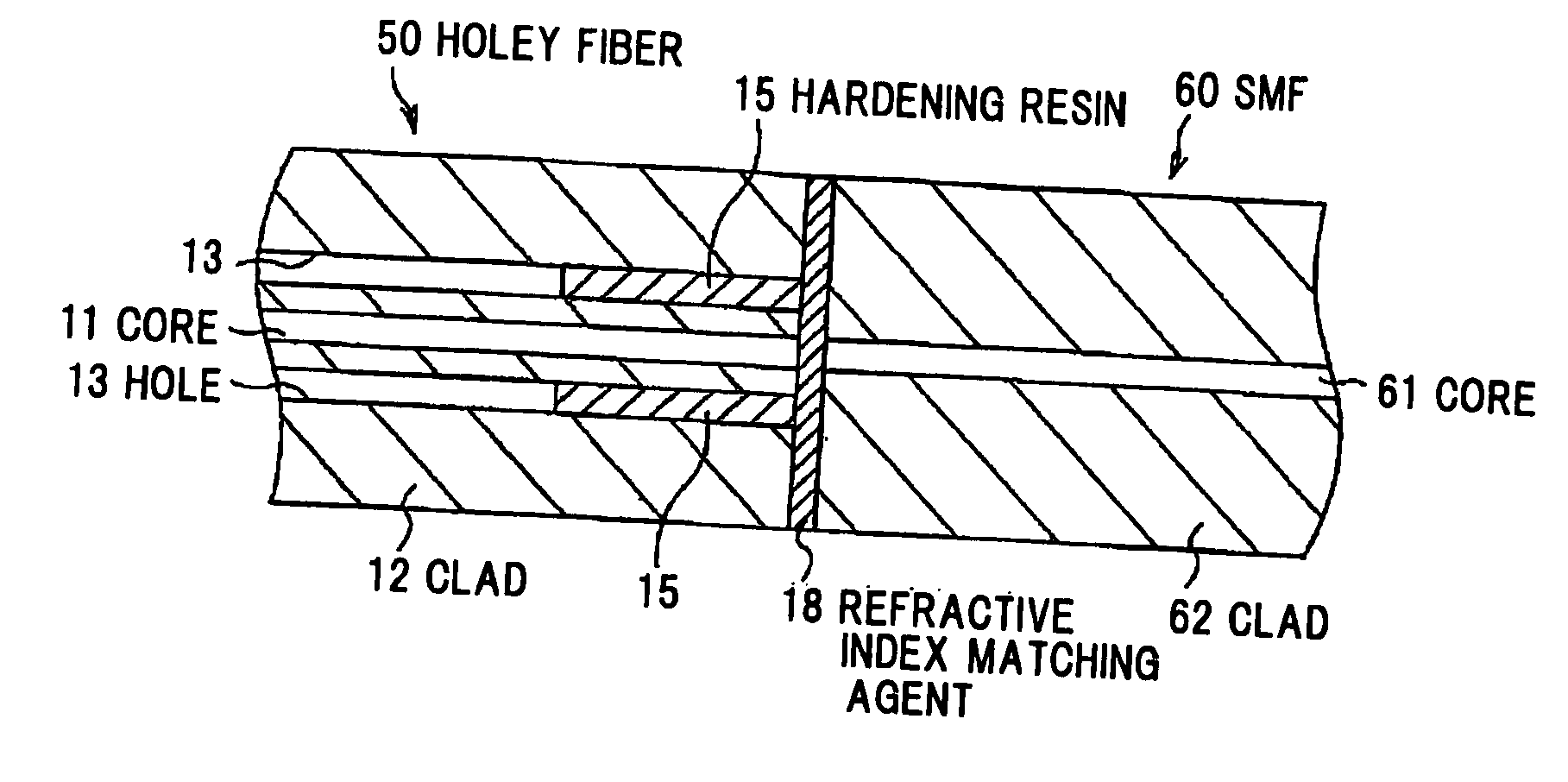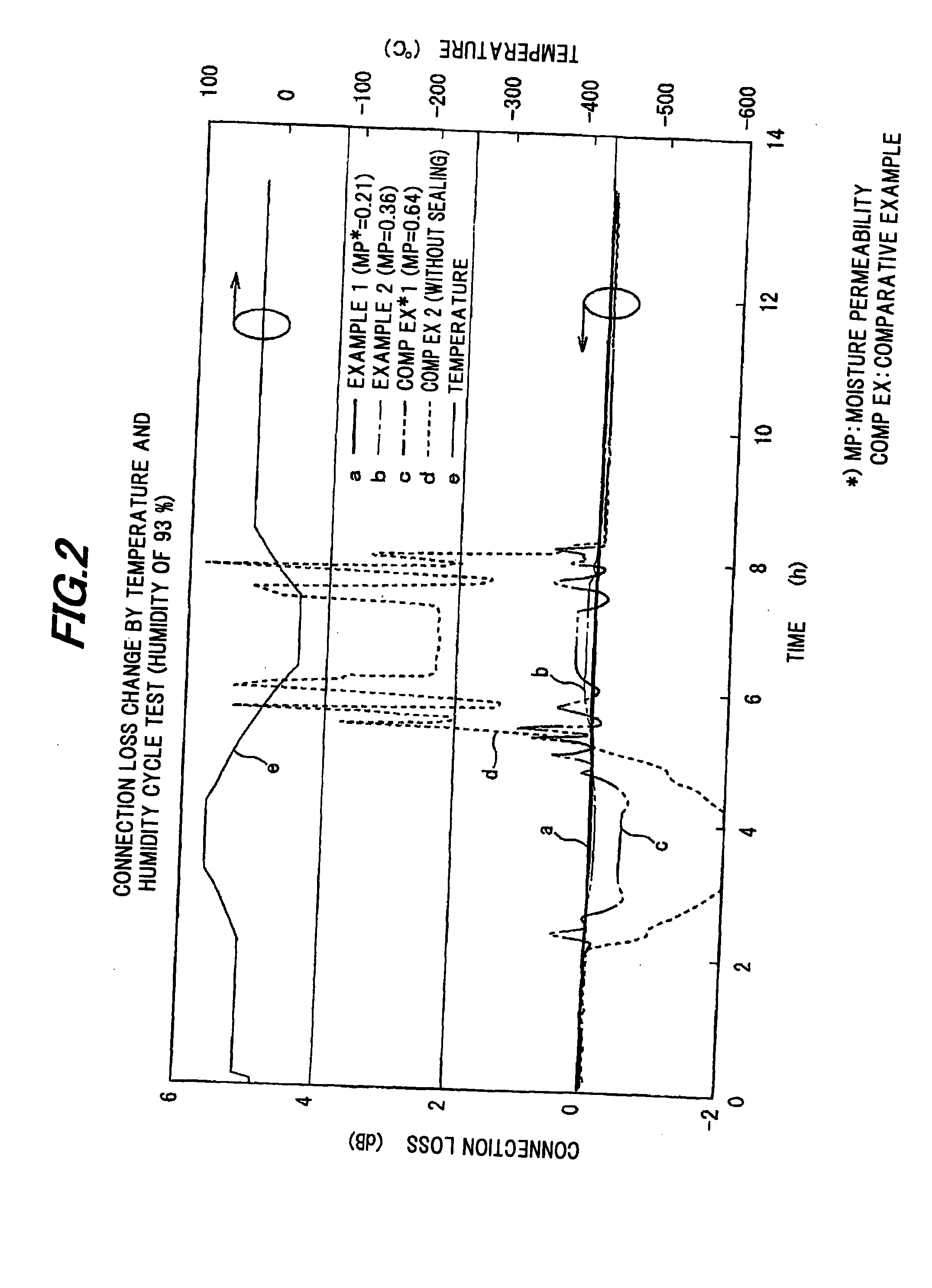Optical fiber, sealing method for optical fiber end face, connection structure of optical fiber, and optical connector
a technology of sealing method and end face, applied in the direction of optical waveguide light guide, optical light guide, instruments, etc., can solve the problems of increased connection loss, decreased long-term reliability, and problems such as problems, to achieve the effect of reducing the loss of optical fiber and increasing long-term reliability
- Summary
- Abstract
- Description
- Claims
- Application Information
AI Technical Summary
Benefits of technology
Problems solved by technology
Method used
Image
Examples
first exemplary embodiment
Configuration of Optical Fiber
[0058]FIGS. 1A and 1B show an optical fiber in a first exemplary embodiment according to the present invention, in which FIG. 1A is a front view and FIG. 1B is a side sectional view of the optical fiber.
[0059]A holey fiber 50 includes a core 11 formed so as to be solid, a clad 12 formed around the core 11, and a plurality of holes 13 which are formed around the core 11 and have a refractive index of about 1. The holey fiber 50 further includes a hardening resin 15 filled in the holes 13 of an optical fiber end face 14. In FIGS. 1A and 1B, an end face of the core 11 is formed so as to constitute the same end face of the holey fiber 50.
[0060]The hardening resin 15 may be a resin having a moisture permeability, after hardening, equal to or less than 0.5 g / cm2·24 hr. If the moisture permeability of the hardening resin 15 is greater than 0.5 g / cm2·24 hr, then a condensation easily occurs in the holes under a high humidity condition, and the transmission loss...
examples
[0072]Next, examples of the present invention are described.
[0073]FIG. 2 is a view showing a connection loss characteristic of the optical fiber in the first exemplary embodiment.
[0074]This represents a change of the connection loss, where an SC (Single Coupling) connector is attached to the end face of the holey fiber 50 in which the holes 13 are sealed by the hardening resin 15, an optical fiber in which a universal SC connector is attached to a normal single mode fiber (SMF) is connected to the holey fiber 50, a connecting part thereof is entered into a constant-temperature bath, and a temperature and humidity cycle test (−40 to +70° C., 93% RH) is performed.
[0075]In FIG. 2, Example 1 is 0.21 g / cm2·24 hr in moisture permeability, Example 2 is 0.36 g / cm2·24 hr in moisture permeability, and Comparative Example 1 is 0.64 g / cm2·24 hr in moisture permeability.
[0076]Clearly, as shown in FIG. 2, a connection loss change of Comparative Example 1 having a high moisture permeability and Co...
second exemplary embodiment
[0100]FIG. 7 is a sectional view showing an optical connector in a second exemplary embodiment according to the present invention. This optical connector 100 includes a ferrule 21 having a hollow fixing portion 22 for fixing the holey fiber 50 and a flange 26, and a fiber holding portion 23 which holds a fiber core wire 17 of the holey fiber 50 and is connected to the ferrule 21.
[0101]The hardening resin 15 is filled in the holes 13 of the holey fiber 50. Thereby, it is prevented that the grinding waste occurring when the optical fiber end face 14 and a ferrule end face 24 are grinded (e.g., polished), enters into the holes 13, and that a crack or a void occurs in the optical fiber end face 14 due to the grinding waste when the optical connector 100 is attached or removed.
[0102]FIG. 8 is a sectional view showing a step of filling a thermosetting resin into a ferrule.
[0103]FIG. 9 is a sectional view showing a step of fixing a holey fiber to the ferrule.
[0104]Hereinafter, referring to...
PUM
| Property | Measurement | Unit |
|---|---|---|
| viscosity | aaaaa | aaaaa |
| refractive index | aaaaa | aaaaa |
| humidity | aaaaa | aaaaa |
Abstract
Description
Claims
Application Information
 Login to View More
Login to View More - R&D
- Intellectual Property
- Life Sciences
- Materials
- Tech Scout
- Unparalleled Data Quality
- Higher Quality Content
- 60% Fewer Hallucinations
Browse by: Latest US Patents, China's latest patents, Technical Efficacy Thesaurus, Application Domain, Technology Topic, Popular Technical Reports.
© 2025 PatSnap. All rights reserved.Legal|Privacy policy|Modern Slavery Act Transparency Statement|Sitemap|About US| Contact US: help@patsnap.com



